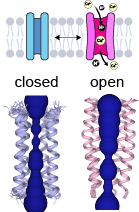Coronavirus envelope protein
| Envelope protein | |||||||||
|---|---|---|---|---|---|---|---|---|---|
virion[1]
● Blue: envelope ● Turquoise: spike glycoprotein (S) ● Bright Pink: envelope proteins (E) ● Green: membrane proteins (M) ● Orange: glycans | |||||||||
| Identifiers | |||||||||
| Symbol | CoV_E | ||||||||
| Pfam | PF02723 | ||||||||
| InterPro | IPR003873 | ||||||||
| PROSITE | PS51926 | ||||||||
| |||||||||
The envelope (E) protein is the smallest and least well-characterized of the four major
Structure
The E protein consists of a short
The transmembrane helices of the E proteins of SARS-CoV and SARS-CoV-2 can
The membrane topology of the E protein has been studied in a number of coronaviruses with inconsistent results; the protein's orientation in the membrane may be variable.[3] The balance of evidence suggests the most common orientation has the C-terminus oriented toward the cytoplasm.[8] Studies of SARS-CoV-2 E protein are consistent with this orientation.[5][9]
Post-translational modifications
In some, but not all, coronaviruses, the E protein is
Expression and localization
Genomic organisation of isolate Wuhan-Hu-1, the earliest sequenced sample of SARS-CoV-2, indicating the location of the E gene | |
| NCBI genome ID | 86693 |
|---|---|
| Genome size | 29,903 bases |
| Year of completion | 2020 |
| Genome browser (UCSC) | |
The E protein is
Function
Essentiality
Studies in different coronaviruses have reached different conclusions about whether E is
Virions and viral assembly
The E protein is found in assembled virions where it forms
Viroporin

In its
The cation leakage may disrupt ion
The E protein's role as a viroporin appears to be involved in
Interactions with host proteins
Evolution and conservation
The sequence of the E protein is not well
References
- ^ Solodovnikov, Alexey; Arkhipova, Valeria (2021-07-29). "Достоверно красиво: как мы сделали 3D-модель SARS-CoV-2" [Truly beautiful: how we made the SARS-CoV-2 3D model] (in Russian). N+1. Archived from the original on 2021-07-30. Retrieved 30 July 2021.
- ^ PMID 31133031.
- ^ PMID 33013759.
- ^ PMID 33813796.
- ^ PMID 33177698.
- PMID 17530462.
- PMID 29474890.
- ^ PMID 32201497.
- PMID 32898469.
- ^ PMID 25093995.
- PMID 12663766.
- ^ PMID 22590676.
- PMID 32760062.
- PMID 18753196.
- ^ PMID 32201500.
- PMID 35380805.
- PMID 37831764.
- PMID 24788150.
- ^ PMID 34103506.
- PMID 17182690.
- PMID 33319124.
- PMID 33385461.
- PMID 35281016.

